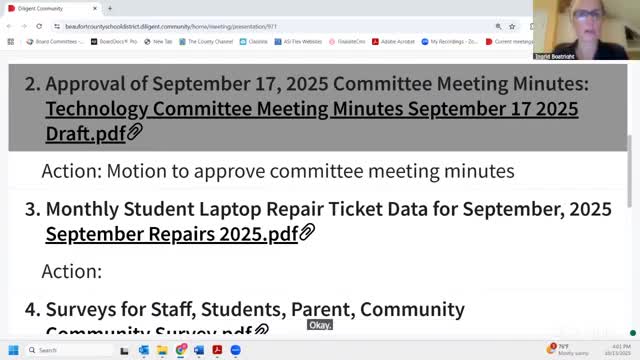Technology committee: Screen cracks top repair issue; district pilots power-bank chargers
October 13, 2025 | Beaufort 01, School Districts, South Carolina
This article was created by AI summarizing key points discussed. AI makes mistakes, so for full details and context, please refer to the video of the full meeting. Please report any errors so we can fix them. Report an error »

Beaufort County School Board Technology Committee members heard Oct. 13 that cracked laptop screens are the single largest repair problem for student devices and that the district is testing portable power-bank chargers to address classroom charging shortages.
At a committee meeting, technology staff presented September repair data and said they split elementary-school reporting into north and south groupings to produce clearer charts. "So once again, we pulled all the student data for the month of September," said Mister Shohan, staff member, who led the presentation.
The presentation and ensuing discussion identified screen cracks as the most frequent repair. Committee members and staff cited device handling and hinge designs on 2-in-1 devices as likely contributors. Shohan said many devices arrive for repair after being carried unsecured in backpacks or dropped at desks.
The committee discussed charging constraints in classrooms. Shohan and members noted problems with embedding electrical outlets in floors because wax and building maintenance can cause floor-mounted connections to fail over time. The committee said rails or furniture-integrated outlets have been used in some labs but are difficult to retrofit into most classroom layouts.
Cost was a central concern. Shohan said small multi-outlet charging stations cost about $500 each and that scaling those across "almost 1,800 classroom areas" would be expensive. To reduce cost and provide short-term relief, the district has begun piloting multi-port power banks for student laptops. "We have used a few in pilot to see how it goes," Shohan said. He described the units as six- to eight-port battery chargers that can provide roughly two to two-and-a-half full laptop charges (and more phone charges), allowing a student to keep working while a device recharges.
Committee members said power banks could reduce the need for spare laptops during testing windows and be easier to deploy districtwide than built-in classroom charging. Shohan said the pilot will run at a limited scale and, if successful, could expand districtwide in about a year.
Committee members also noted existing expectations in district policy that students should charge devices overnight. "It is that they should charge their laptops at night to have them ready for the school day. It is in the AUP," Shohan said, referring to the district Acceptable Use Policy.
No formal action was taken. Staff were directed to continue the repair program, run the power-bank pilot, and report results and recommendations at future committee meetings.
Ending: The committee asked staff to return with updated repair reports and pilot results at the next meeting; technology staff said they will include pilot updates in regular reports and highlight new pilots publicly when appropriate.
At a committee meeting, technology staff presented September repair data and said they split elementary-school reporting into north and south groupings to produce clearer charts. "So once again, we pulled all the student data for the month of September," said Mister Shohan, staff member, who led the presentation.
The presentation and ensuing discussion identified screen cracks as the most frequent repair. Committee members and staff cited device handling and hinge designs on 2-in-1 devices as likely contributors. Shohan said many devices arrive for repair after being carried unsecured in backpacks or dropped at desks.
The committee discussed charging constraints in classrooms. Shohan and members noted problems with embedding electrical outlets in floors because wax and building maintenance can cause floor-mounted connections to fail over time. The committee said rails or furniture-integrated outlets have been used in some labs but are difficult to retrofit into most classroom layouts.
Cost was a central concern. Shohan said small multi-outlet charging stations cost about $500 each and that scaling those across "almost 1,800 classroom areas" would be expensive. To reduce cost and provide short-term relief, the district has begun piloting multi-port power banks for student laptops. "We have used a few in pilot to see how it goes," Shohan said. He described the units as six- to eight-port battery chargers that can provide roughly two to two-and-a-half full laptop charges (and more phone charges), allowing a student to keep working while a device recharges.
Committee members said power banks could reduce the need for spare laptops during testing windows and be easier to deploy districtwide than built-in classroom charging. Shohan said the pilot will run at a limited scale and, if successful, could expand districtwide in about a year.
Committee members also noted existing expectations in district policy that students should charge devices overnight. "It is that they should charge their laptops at night to have them ready for the school day. It is in the AUP," Shohan said, referring to the district Acceptable Use Policy.
No formal action was taken. Staff were directed to continue the repair program, run the power-bank pilot, and report results and recommendations at future committee meetings.
Ending: The committee asked staff to return with updated repair reports and pilot results at the next meeting; technology staff said they will include pilot updates in regular reports and highlight new pilots publicly when appropriate.
View full meeting
This article is based on a recent meeting—watch the full video and explore the complete transcript for deeper insights into the discussion.
View full meeting